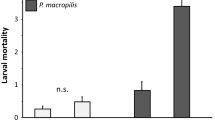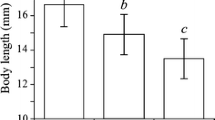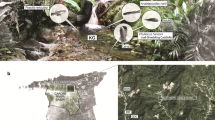Abstract
Interactions between different size classes of predator species have the potential to influence survival of prey species in intraguild predation (IGP) systems, but few studies test for these effects. Using a substitutive design in a field setting, I measured the effects of two size classes of IG predators (large and small larvae of the dragonfly Anax junius) on the mortality of IG prey (larvae of the dragonfly Pachydiplax longipennis). I also examined whether combinations of large A. junius and P. longipennis and small A. junius and P. longipennis had substitutable effects on shared prey (larvae of the damselfly Ischnura verticalis). The presence of both size classes of A. junius, when alone and in combination with P. longipennis, significantly increased mortality of I. verticalis. In the presence of P. longipennis, large and small A. junius had similar effects on the mortality of I. verticalis, and effects of size-structured assemblages of A. junius were similar to the effects of each size class alone at the same density. The effects of the two size classes of A. junius on P. longipennis differed, and P. longipennis mortality was lower when exposed to size structured assemblages of A. junius than when exposed to only large A. junius at the same density. Results were similar to those in a laboratory study, although the effect of P. longipennis on I. verticalis was much lower in the field setting. These results demonstrate that interactions between different size classes of IG predators promote the survival of IG prey and highlight the importance of within-species size structure as a characteristic that may promote the coexistence of predators in IGP systems.


Similar content being viewed by others
References
Beeck P, Tauber S, Kiel S, Borcherding J (2002) 0+ perch predation on 0+ bream: a case study in a eutrophic gravel pit lake. Freshwat Biol 47:2359–2369
Bell GW, Buckel JA, Stoner AW (1999) Effects of alternative prey on cannibalism in age-1 bluefish. J Fish Biol 55:990–1000
Brabrand A (2001) Piscivory in larval perch (Perca fluviatilis): mechanisms structuring larval roach (Rutilus rutilus) cohorts. Ecol Freshwat Fish 10:97–104
Buckel JA, McKown KA (2002) Competition between juvenile striped bass and bluefish: resource partitioning and growth rate. Mar Ecol Prog Ser 234:191–204
Buckel JA, Conover DO, Steinberg ND, McKown KA (1999a) Impact of age-0 bluefish (Pomatomus saltatrix) predation on age-0 fishes in the Hudson River estuary: evidence for density-dependent loss of juvenile striped bass (Morone saxatilis). Can J Fish Aquat Sci 56:275–287
Buckel JA, Fogarty MJ, Conover DO (1999b) Foraging habits of bluefish, Pomatomus saltatrix, on the US east coast continental shelf. Fish Bull 97:758–775
Calvert PP (1934) The rates of growth, larval development and seasonal distribution of dragonflies of the genus Anax (Odonata: Aeshnidae). PAPS 73:1–70
Cohen JE (1989) Food webs and community structure. In: Roughgarden J, May RM, Levin SA (eds) Perspectives on ecological theory. Princeton University Press, Princeton, New Jersey, pp 181–202
Corbet PS (1999) Dragonflies: behavior and ecology of Odonata. Cornell University Press, Ithaca
Crowder LB, Squires DD, Rice JA (1997) Nonadditive effects of terrestrial and aquatic predators on juvenile estuarine fish. Ecology 78:1796–1804
Crowley PH, Hopper KR (1994) How to behave around cannibals: a density dependent dynamic game. Am Nat 143:117–154
Crowley PH, Dillon PD, Johnson DM, Watson CN (1987) Intraspecific interference among larvae in a semivoltine dragonfly population. Oecologia 71:447–456
Crumrine PW, Crowley PH (2003) Partitioning components of risk reduction in a dragonfly-fish intraguild predation system. Ecology 84:1588–1597
Diehl S (1995) Direct and Indirect effects of omnivory in a littoral lake community. Ecology 76:1727–1740
Dunkle SW (1989) Dragonflies of the Florida Peninsula, Bermuda and the Bahamas. Scientific Publishers, Gainesville
Dunkle SW (2000) Dragonflies through binoculars: a field guide to dragonflies of North America. Oxford University Press, New York
Ebenman B, Persson L (1988) Size structured populations: ecology and evolution. Springer, Berlin, Heidelberg, New York
Eklov P, VanKooten T (2001) Facilitation among piscivorous predators: effects of prey habitat use. Ecology 82:2486–2494
Evans EW (1991) Intra- versus interspecific interactions of ladybeetles (Coleptera: Coccinellidae) attacking aphids. Oecologia 85:401–408
Hartman KJ (2000) The influence of size on striped bass foraging. Mar Ecol Prog Ser 194:263–268
Holt RD, Polis GA (1997) A theoretical framework for intraguild predation. Am Nat 149:745–764
Hopper KR (1998) Cannibalism and predation in larval dragonflies. Ph.D. Dissertation: School of Biological Sciences. University of Kentucky, Lexington, Kentucky
Huang CF, Sih A (1991) An experimental study on the effects of salamander larvae on isopods in stream pools. Freshwat Biol 25:451–459
Johansson F (1991) Foraging modes in an assemblage of odonate larvae: effects of prey and interference. Hydrobiologia 209:79–87
Johansson F (1993) Intraguild predation and cannibalism in odonate larvae - effects on foraging behavior and zooplankton availability. Oikos 66:80–87
Johnson DM (1991) Behavioral ecology of larval dragonflies and damselflies. Trends Ecol Evol 6:8–13
Johnson DM, Crowley PH (1980) Habitat and seasonal segregation among coexisting odonate larvae. Odonatologica 9:297–308
Johnson DM, Pierce CL, Martin TH, Watson CN, Bohanan RE, Crowley PH (1987) Prey depletion by odonate larvae: combining evidence from multiple field experiments. Ecology 68:1459–1465
Kerfoot WC, Sih A (eds) (1987) Predation: direct and indirect impacts on aquatic communities. University Press of New England, Hanover
Levin SA (1992) The problem of pattern and scale in ecology. Ecology 73:1943–1967
Lima SL, Dill LM (1990) Behavioral decisions made under the risk of predation: a review and prospectus. Can J Zool 68:619–640
Losey JE, Denno RF (1998) Positive predator-predator interactions: enhanced predation rates and synergistic suppression of aphid populations. Ecology 79:2143–2152
May ML (1992) Migrating dragonflies in North America. Argia 4:4–8
McPeek MA (1990) Determination of species composition in the Enallagma damselfly assemblages of permanent lakes. Ecology 71:83–98
McPeek MA (1998) The consequences of changing the top predator in a food web: a comparative experimental approach. Ecol Monogr 68:1–23
Menge BA, Sutherland JP (1987) Community regulation: variation in disturbance, competition, and predation in relation to gradients of environmental stress and recruitment. Am Nat 130:730–757
Munch SB, Conover DO (2000) Recruitment dynamics of bluefish (Pomatomus saltatrix) from Cape Hatteras to Cape Cod, 1973–1995. ICES J Mar Sci 57:393–402
Mylius SD, Klumpers K, de Roos AM, Persson L (2001) Impact of intraguild predation and stage structure on simple communities along a productivity gradient. Am Nat 158:259–276
Needham JG, Westfall MW, May ML (2000) Dragonflies of North America. Scientific Publishers, Gainesville
Oksanen L, Fretwell SJ, Arruda J, Niemela P (1981) Exploitation ecosystems in gradients of primary productivity. Am Nat 118:240–261
Okuyama T (2002) The role of antipredator behavior in an experimental community of jumping spiders with intraguild predation. Pop Ecol 44:121–125
Peckarsky BL (1991) Mechanisms of intraspecific and interspecific interference between larval stoneflies. Oecologia 85:521–529
Persson L, Eklov P (1995) Prey refuges affecting interactions between piscivorous perch and juvenile perch and roach. Ecology 76:70–81
Persson L, Bystrom P, Wahlstrom E (2000) Cannibalism and competition in Eurasian perch: population dynamics of an ontogenetic omnivore. Ecology 81:1058–1071
Pimm S (1982) Food webs. Chapman& Hall, New York, New York
Polis GA (1991) Complex trophic interactions in deserts - an empirical critique of food-web theory. Am Nat 138:123–155
Polis GA, McCormick S (1987) Intraguild predation and competition among desert scorpions. Ecology 68:332–343
Polis GA, Strong DR (1996) Food web complexity and community dynamics. Am Nat 147:813–846
Relyea RA (2003) How prey respond to combined predators: a review and empirical test. Ecology 84: 1827–1839
Rosenheim JA, Willhoit LR, Armer CA (1993) Influence of intraguild predation among generalist predators on the suppression of an herbivore population. Oecologia 108:439–449
Ross QE (1971) The effect of intraspecific interactions on the growth and feeding behavior of Anax junius (Drury) naiads. Ph.D. Dissertation, Department of Zoology. Michigan State University, East Lansing, Michigan
Russell RW, May ML, Soltesz KL, Fitzpatrick JW (1998) Massive swarm migrations of dragonflies. Am Midl Nat 140:325–336
Schmitz OJ (1998) Direct and indirect effects of predation and predation risk in old-field interaction webs. Am Nat 151:327–342
Schmitz OJ (2002) Linearity in the aggregate effects of multiple predators in a food web. Ecol Lett 5:168–172
Schmitz OJ, Suttle KB (2001) Effects of top predator species on direct and indirect interactions in a food web. Ecology 82:2072–2081
Schoener TW (1989) Food webs from the small to large. Ecology 70:1559–1589
Sih A, Crowley P, McPeek M, Petranka J, Strohmeirer K (1985) Predation, competition, and prey communities: a review of field experiments. Annu Rev of Ecol and Syst 16:269–311
Sih A, Englund G, Wooster D (1998) Emergent impacts of multiple predators on prey. Trends Ecol Evol 13:350–355
Sokol-Hessner L, Schmitz OJ (2002) Aggregate effects of multiple predator species on a shared prey. Ecology 83:2367–2372
Soluk DA (1993) Multiple predator effects: predicting combined functional response of stream fish and invertebrate predators. Ecology 74:219–225
Soluk DA, Collins NC (1988) Synergistic interactions between fish and stoneflies: facilitation and interference between stream predators. Oikos 52:94–100
Swisher BJ, Soluk DA, Wahl DH (1998) Non-additive predation in littoral habitats: influences of habitat complexity. Oikos 81:30–37
Trottier R (1966) The emergence and sex ratio of Anax junius Drury (Odonata:Aeshnidae) in Canada. Can Entomol 98:794–798
Trottier R (1971) Effect of temperature on the life-cycle of Anax junius Drury (Odonata:Aeshnidae) in Canada. Can Entomol 103:1671–1683
Van Buskirk J (1992) Competition, cannibalism, and size class dominance in a dragonfly. Oikos 65:455–464
Werner EE, Gilliam JF (1984) The ontogenetic niche and species interactions in size-structured populations. Annu Rev Ecol Syst 15:393–425
Westfall MJ, May ML (1996) Damselflies of North America. Scientific Publishers, Gainesville
Wissinger SA (1988) Life history and size structure of larval dragonfly populations. J N Am Benthol Soc 7:13–28
Wissinger SA (1989) Seasonal variation in the intensity of competition and predation among dragonfly larvae. Ecology 70:1017–1027
Wissinger SA (1992) Niche overlap and the potential for competition and intraguild predation between size-structured populations. Ecology 73:1431–1444
Wissinger SA, McGrady J (1993) Intraguild predation and competition between larval dragonflies - direct and indirect effects on shared prey. Ecology 74:207–218
Young AM (1967) The flying season and emergence period of Anax junius in Illinois (Odonata:Aeshnidae). Can Entomol 99:886–890
Acknowledgements
I thank Philip Crowley and Andrew Sih for their support and guidance during this study and Melissa Zwick for her encouragement and logistical support. I thank Stephen Moore for his enthusiastic assistance in conducting the fieldwork. Jay Rosenheim and two anonymous reviewers provided valuable feedback that improved this paper. This study was funded by a grant from the Ribble Research Fund at the University of Kentucky and National Science Foundation Grant DEB-0206549 to Patrick Crumrine and Philip Crowley.
Author information
Authors and Affiliations
Corresponding author
Additional information
Communicated by Jay Rosenheim
Rights and permissions
About this article
Cite this article
Crumrine, P.W. Size structure and substitutability in an odonate intraguild predation system. Oecologia 145, 132–139 (2005). https://doi.org/10.1007/s00442-005-0084-6
Received:
Accepted:
Published:
Issue Date:
DOI: https://doi.org/10.1007/s00442-005-0084-6




